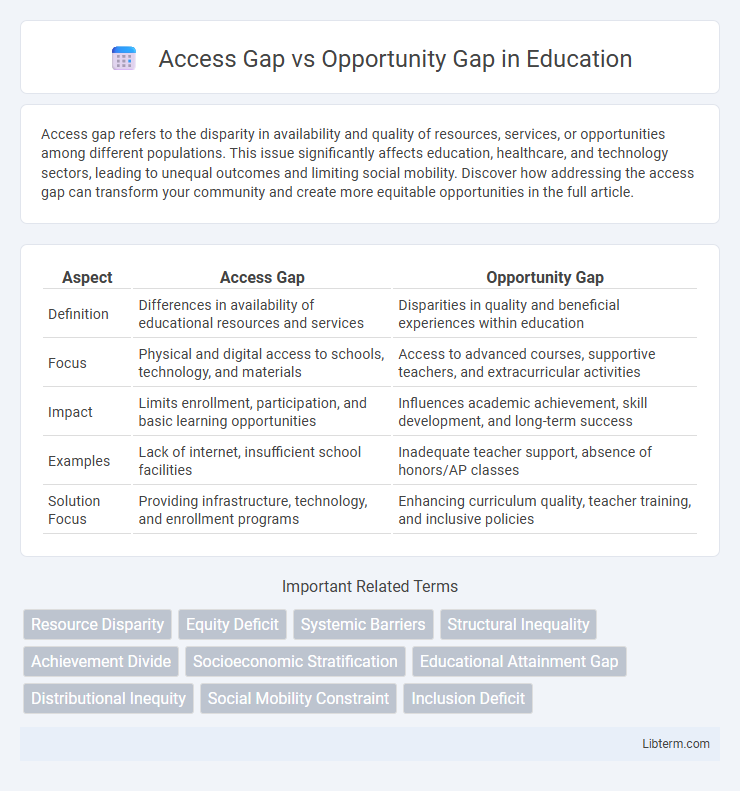Access gap refers to the disparity in availability and quality of resources, services, or opportunities among different populations. This issue significantly affects education, healthcare, and technology sectors, leading to unequal outcomes and limiting social mobility. Discover how addressing the access gap can transform your community and create more equitable opportunities in the full article.
Table of Comparison
| Aspect | Access Gap | Opportunity Gap |
|---|---|---|
| Definition | Differences in availability of educational resources and services | Disparities in quality and beneficial experiences within education |
| Focus | Physical and digital access to schools, technology, and materials | Access to advanced courses, supportive teachers, and extracurricular activities |
| Impact | Limits enrollment, participation, and basic learning opportunities | Influences academic achievement, skill development, and long-term success |
| Examples | Lack of internet, insufficient school facilities | Inadequate teacher support, absence of honors/AP classes |
| Solution Focus | Providing infrastructure, technology, and enrollment programs | Enhancing curriculum quality, teacher training, and inclusive policies |
Understanding the Concepts: Access Gap vs Opportunity Gap
The Access Gap refers to disparities in the availability of essential resources such as technology, education, and healthcare, often influenced by socioeconomic status or geographic location. The Opportunity Gap involves differences in the quality and range of experiences, support, and environments that enable individuals to develop skills and achieve success. Understanding these gaps highlights the necessity for targeted interventions that not only provide equal resources but also foster equitable conditions for personal and academic growth.
Historical Context of Access and Opportunity Gaps
The historical context of access and opportunity gaps reveals systemic barriers rooted in racial segregation, socioeconomic disparities, and discriminatory policies, such as redlining and unequal school funding. Access gaps refer to the unequal availability of resources like quality education, technology, and healthcare, while opportunity gaps emphasize the broader societal conditions limiting individuals' potential to succeed. Persistent inequalities from these historical injustices continue to shape educational and economic outcomes across marginalized communities.
Key Differences Between Access Gap and Opportunity Gap
The access gap refers to disparities in availability or entry to resources, services, or technology, while the opportunity gap highlights differences in the quality of experiences and the chances for success or advancement. Access gaps focus on physical or systemic barriers that prevent participation, such as lack of internet or educational materials. Opportunity gaps emphasize inequalities in the support, encouragement, and pathways that foster achievement and growth beyond mere access.
Impact of Access Gaps on Student Outcomes
Access gaps, characterized by unequal availability of educational resources such as technology, qualified teachers, and advanced coursework, directly hinder student achievement by limiting learning opportunities. Students affected by access gaps often experience lower academic performance, reduced graduation rates, and diminished college enrollment, perpetuating cycles of educational inequity. Bridging these access gaps is essential to improving overall student outcomes and fostering equitable educational environments.
Opportunity Gap: Beyond Physical Access
The Opportunity Gap extends beyond mere physical access to resources or facilities, encompassing disparities in the quality and availability of educational, economic, and social opportunities. It reflects systemic inequalities in access to advanced learning programs, mentorship, technology, and networks that enable success, particularly for marginalized communities. Addressing the Opportunity Gap requires targeted investments in equitable policies, support systems, and inclusive environments that foster long-term achievement and upward mobility.
Socioeconomic Factors Influencing Education Gaps
Socioeconomic factors significantly influence both the access gap and opportunity gap in education, where limited financial resources restrict access to quality schools, technology, and learning materials. Families with lower socioeconomic status often face barriers such as inadequate school funding, lack of extracurricular opportunities, and limited social capital, which exacerbate disparities in educational outcomes. These gaps perpetuate systemic inequality, as students from disadvantaged backgrounds receive fewer chances to develop skills and attain academic success compared to their wealthier peers.
Measuring Access vs Opportunity in Schools
Measuring access in schools focuses on quantifying the availability of resources, such as advanced courses, technology, and extracurricular programs, to all students regardless of background. Opportunity gaps assess the disparities in the quality and effectiveness of those resources, examining how differences in teaching quality, school culture, and support services impact student outcomes. Data on enrollment rates, resource allocation, and student performance metrics are essential for distinguishing between access gaps and opportunity gaps in educational settings.
Policy Solutions to Bridge Education Gaps
Policy solutions to bridge the access gap focus on expanding equitable resource distribution, such as increasing funding for schools in underserved areas and enhancing broadband connectivity for remote learning. To address the opportunity gap, policies emphasize inclusive curriculum development, targeted teacher training, and support programs like after-school tutoring and mentorship to foster academic growth for all students. Effective legislation integrates both approaches by promoting systemic reforms that ensure equal access to quality education and meaningful learning opportunities.
Case Studies: Addressing Access and Opportunity Inequities
Case studies addressing access and opportunity gaps highlight targeted interventions such as expanding broadband in rural areas and redesigning curriculum to include diverse perspectives. Initiatives like the Digital Equity Pilot Program demonstrate measurable improvements in technology access, while Opportunity Zones in education show increased participation and success rates among marginalized groups. These examples underscore the critical need for data-driven strategies to close both access and opportunity inequities in various sectors.
Future Directions for Equity in Education
Access Gap refers to disparities in the availability of educational resources and opportunities, while Opportunity Gap highlights the uneven conditions that affect students' ability to benefit from available education. Future directions for equity in education emphasize integrating technology to bridge the access gap and implementing culturally responsive teaching to address the opportunity gap. Policy reforms must focus on equitable funding, enhanced teacher training, and community engagement to create inclusive learning environments that support all students.
Access Gap Infographic

 libterm.com
libterm.com